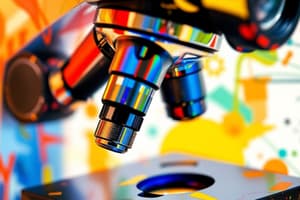Podcast
Questions and Answers
What is the primary function of the objective lens in a light microscope?
What is the primary function of the objective lens in a light microscope?
- To hold the slide in place
- To gather light and focus the image (correct)
- To magnify the image further
- To reflect light to the lens
What is the purpose of the diaphragm in a light microscope?
What is the purpose of the diaphragm in a light microscope?
- To hold the objective lenses
- To reflect light to the lens
- To magnify the image
- To control the amount of light on the slide (correct)
What type of microscope uses a beam of electrons to produce an image?
What type of microscope uses a beam of electrons to produce an image?
- Light microscope
- Electron microscope (correct)
- Dark-field microscope
- Fluorescent microscope
What is the purpose of the coarse adjustment knob?
What is the purpose of the coarse adjustment knob?
What is the function of the nose piece in a light microscope?
What is the function of the nose piece in a light microscope?
What is the magnification of the image if the ocular lens is 10x and the objective lens is 40x?
What is the magnification of the image if the ocular lens is 10x and the objective lens is 40x?
What is the purpose of the body tube in a light microscope?
What is the purpose of the body tube in a light microscope?
How should you clean a microscope?
How should you clean a microscope?
What should you do when carrying a microscope?
What should you do when carrying a microscope?
What should you do first when using a microscope?
What should you do first when using a microscope?
Flashcards are hidden until you start studying
Study Notes
Types of Microscopes
- There are six types of microscopes: light microscope, dark-field microscope, phase-contrast microscope, fluorescent microscope, transmission electron microscope (TEM), and scanning electron microscope (SEM)
How a Light Microscope Works
- The light microscope consists of an ocular lens, objective lens, body tube, and other components
- The objective lens gathers light, magnifies, and focuses the image inside the body tube
- The ocular lens magnifies the image again
- The body tube supports the eyepiece and lenses and maintains the proper distance between them
- The process of bending light involves the objective lens magnifying and focusing the image, and the ocular lens magnifying it again
Microscope Components
- Eyepiece/Ocular Lens: magnifies the specimen image, where you look through to view the object
- Body Tube: supports the eyepiece and lenses, maintains proper distance between them
- Nose Piece: holds the objective lenses, can be turned to increase magnification
- Objective Lenses: magnify the images of the specimen to form an enlarged image
- Stage Clips: hold the slide/specimen in place on the stage
- Diaphragm: controls the amount of light on the slide/specimen
- Mirror: reflects light to the lens of the microscope
- Arm: frame to which the base, body, and stage are attached
- Stage: supports the slide/specimen
- Coarse Adjustment Knob: moves the stage up and down for larger focusing of the image
- Fine Adjustment Knob: moves the stage slightly to sharpen the image for precision focusing
- Base: supports the microscope and is used for carrying it
Magnification
- To determine magnification, multiply the ocular lens by the objective lens
- Ocular lens usually magnifies by 10x, and objective lenses have their magnification written on them
Caring for a Microscope
- Clean only with a soft cloth/tissue
- Make sure it's on a flat surface
- Carry it with two hands, one on the arm and the other on the base
Using a Microscope
- Start on the lowest magnification
- Don't use the coarse adjustment knob on high magnification
- Place the slide on the stage and lock the clips
- Adjust the light source/mirror
- Use the fine adjustment to focus
Studying That Suits You
Use AI to generate personalized quizzes and flashcards to suit your learning preferences.




